PULLMAN COMPANY
24 Duplex Roomette Sleeper, Plan 4100, “L. S. Hungerford”

In the spring of 1942, Pullman out-shopped a unique streamlined sleeping car having 24 duplex roomettes as Plan 4100. The objective was to see if such a car would be accepted by the traveling public and the railroads as a possible replacement for dated, heavy-weight 14 and 12 section sleeping cars.
With new roomettes becoming popular in the late 1930s, such a car would have similar, although somewhat condensed private accommodations for one person. Appearing in Pullman’s new two-tone gray pool service livery, it was unimaginatively named “Duplex Roomette 1.” Soon after this new car arrived in service, WW II broke out. That precluded securing any orders to build more of its type.
In Pullman pool service, this car was assigned to the New York Central from 1942-1945. For 1946-1947 it was on the Pennsylvania Railroad’s General. Withdrawn by 1948, in 1949 Pullman renamed it “L. S. Hungerford” after a former Pullman Company executive and repainted it in Great Northern livery were it was assigned to the Empire Builder. By 1951 it was running on the Santa Fe in the Grand Canyon’s consist. Repainted again this time in B&O blue and gray, the “L. S. Hungerford” was mainly used in the Ambassador but did work other B&O trains as well, from 1952 to 1961.
It was again withdrawn from service by Pullman, which retained ownership of this car after the ‘breakup’ of 1949. It was sold to the Pickens Railroad in 1965, which in turn sold it to the National of Mexico in 1967, where it was renamed “Paricutin.” Although the only car of its plan, some 30 additional 24 duplex roomette sleepers were built after WW II to Plan 4100 in subclasses A, B and C with the cars having fluted sides and other minor differences.
In 1947, Kasiner Hobbies of Rochester NY began production of O scale streamlined passenger car kits having extruded aluminum bodies. Each kit was made to model a specific prototype car. The first kits had smooth sides, with Kit Number 1 was Pullman’s 18 roomette sleepers of 1939. Kit Number 2 followed, advertised as the “sleeping car with staggered windows.” This would be the model for “Duplex Roomette I” of April, 1942. The oddity of the window arrangement appealed to those who wanted the newest thing. These cars still show up for sale at train meets and on eBay. Because a smooth sided car needs extra care and work to apply a good paint job, not all are at their best in the used market. 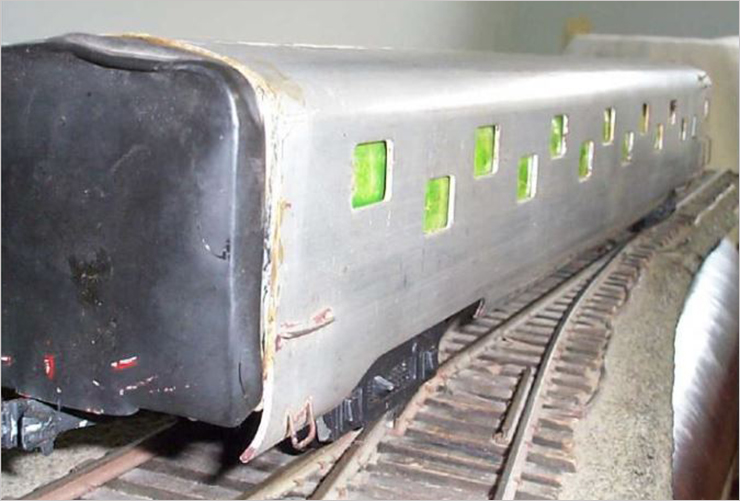 Found on eBay for $10 in 2003, this car will need a few touches here and there to become the “L. S. Hungerford” in B&O livery. The builder tried to make full width diaphragms for it.
Found on eBay for $10 in 2003, this car will need a few touches here and there to become the “L. S. Hungerford” in B&O livery. The builder tried to make full width diaphragms for it.
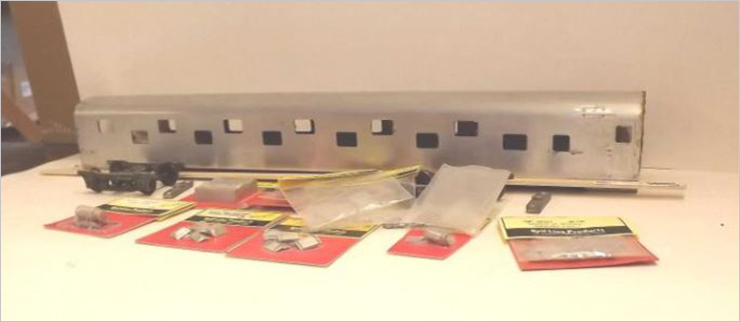 The best thing for old ‘junker’ is to put it back in to kit form by completely disassembling it and cleaning the parts to be used again. Also a supply of new detail parts will be needed to upgrade the model’s appearance. To ‘update’ the model for B&O, the center skirting was removed with a Dremel cut-off wheel and filing.
The best thing for old ‘junker’ is to put it back in to kit form by completely disassembling it and cleaning the parts to be used again. Also a supply of new detail parts will be needed to upgrade the model’s appearance. To ‘update’ the model for B&O, the center skirting was removed with a Dremel cut-off wheel and filing.
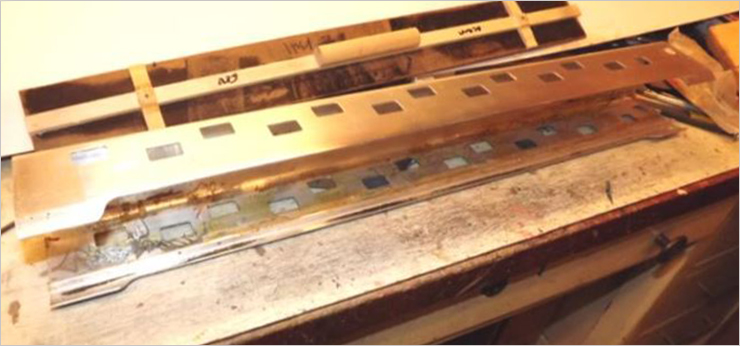 The original Masonite floor was salvaged and given a new center sill and bolsters. Removing the old horse hide glue used to secure plastic glazing from the late 1940s proved to be a challenge and a half.
The original Masonite floor was salvaged and given a new center sill and bolsters. Removing the old horse hide glue used to secure plastic glazing from the late 1940s proved to be a challenge and a half.
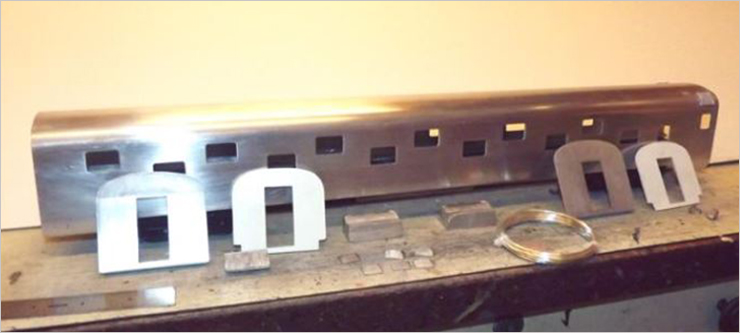 But the job was done and the body was cleaned up. Holes were filled with Devcon epoxy. New holes were drilled for the grab irons and hand rails, which were made with .025” diameter nickel silver wire from the jewelry aisle at a Michaels craft store. In natural finish, it represents the chrome plated handrails of the prototype. New car ends were made from aluminum sheet roofer’s flashing with styrene backers. A third styrene backer with a door in the opening will become the inside vestibule wall. Roof details were applied using photos as a guide.
But the job was done and the body was cleaned up. Holes were filled with Devcon epoxy. New holes were drilled for the grab irons and hand rails, which were made with .025” diameter nickel silver wire from the jewelry aisle at a Michaels craft store. In natural finish, it represents the chrome plated handrails of the prototype. New car ends were made from aluminum sheet roofer’s flashing with styrene backers. A third styrene backer with a door in the opening will become the inside vestibule wall. Roof details were applied using photos as a guide.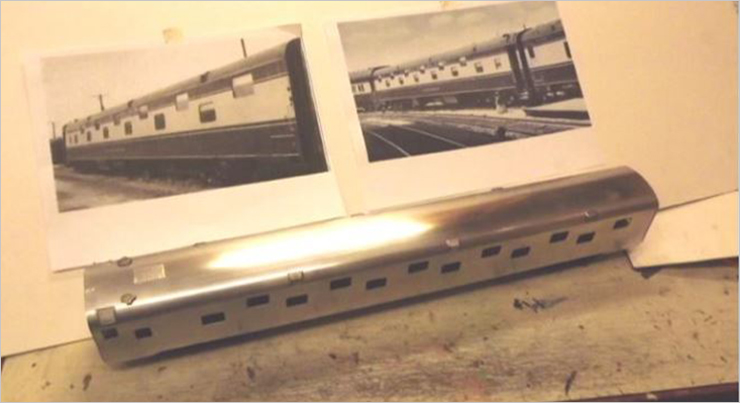
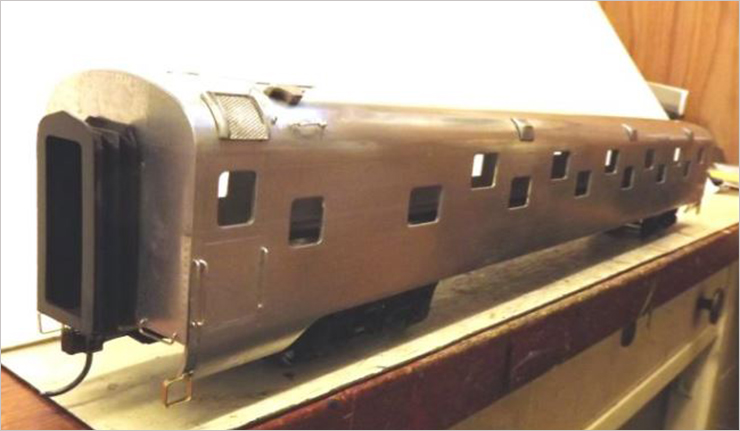 Handrails and grab irons were added. Also the doors on each side were marked off with scribed lines. After painting, the doors will be outlined with thin black decal striping.
Handrails and grab irons were added. Also the doors on each side were marked off with scribed lines. After painting, the doors will be outlined with thin black decal striping.
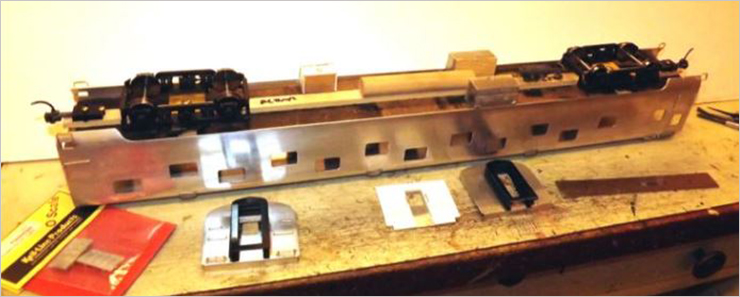 Now standing on its roof, underbody parts are being fitted up. The inside vestibule wall can also be seen, with its door in place. Golden Gate Depot trucks were installed. To do that, new brass bolster plates were made to have the car at its proper riding height. Long shank 700 series Kadee couplers were also installed.
Now standing on its roof, underbody parts are being fitted up. The inside vestibule wall can also be seen, with its door in place. Golden Gate Depot trucks were installed. To do that, new brass bolster plates were made to have the car at its proper riding height. Long shank 700 series Kadee couplers were also installed.
 With all the exterior work finished, the car is ready for the next steps of interior detail, lighting and paint. The left end of his car is the front and all the roomette seats face in that direction.
With all the exterior work finished, the car is ready for the next steps of interior detail, lighting and paint. The left end of his car is the front and all the roomette seats face in that direction.
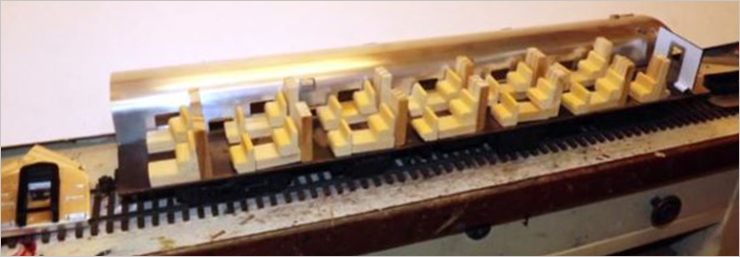 Each upper and lower roomette was made with milled wood seat stock and scrap pieces of MDF left over from other carpentry projects. It works nicely and takes paint very well.
Each upper and lower roomette was made with milled wood seat stock and scrap pieces of MDF left over from other carpentry projects. It works nicely and takes paint very well.
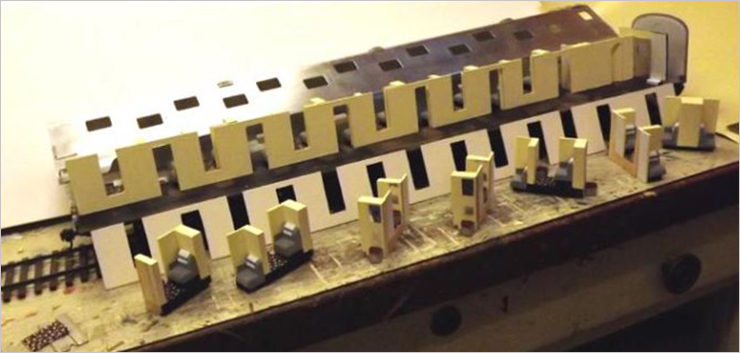 The two inside walls were cut from mat board used for picture framing. Each left and right duplex roomette set was painted and detailed with a ’toilet’ block, fold up sink, mirror, head rest cover, arm rest and carpet. Because the Kasiner body has flanges that fit above the floor, each roomette set has an undercut to clear it when the body is slid into place when assembling the car.
The two inside walls were cut from mat board used for picture framing. Each left and right duplex roomette set was painted and detailed with a ’toilet’ block, fold up sink, mirror, head rest cover, arm rest and carpet. Because the Kasiner body has flanges that fit above the floor, each roomette set has an undercut to clear it when the body is slid into place when assembling the car. 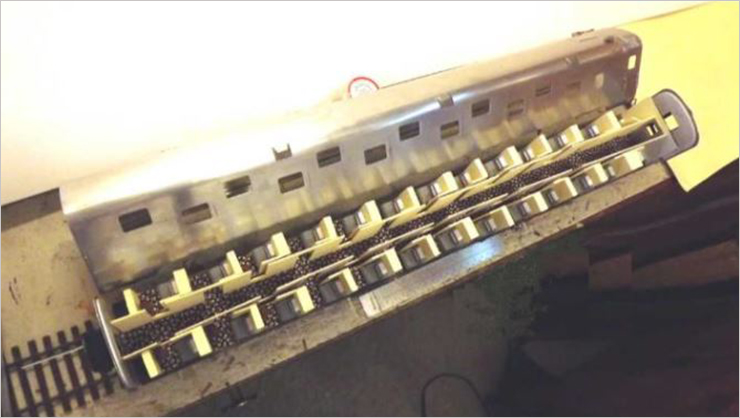
 The LED lighting from Golden Gate Depot used a full strip wired to a half strip to gain even illumination inside the car. The LEDs face up, to the underside of the car roof which was polished to a high shine. The reflected light will provide an even glow. Passengers are also being put into their reserved spaces.
The LED lighting from Golden Gate Depot used a full strip wired to a half strip to gain even illumination inside the car. The LEDs face up, to the underside of the car roof which was polished to a high shine. The reflected light will provide an even glow. Passengers are also being put into their reserved spaces.
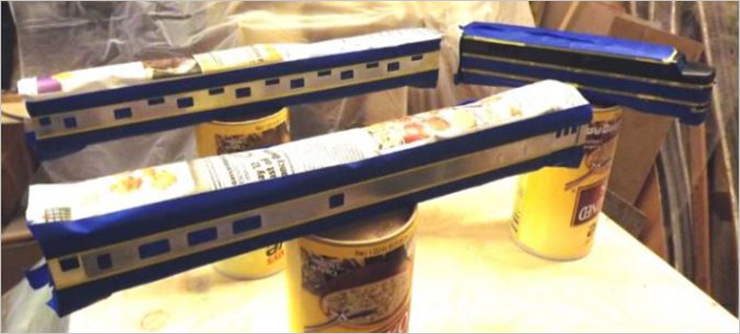 The body has been masked for its coat of B&O Gray, along with two other projects on the work bench at the same time. B&O Royal Blue will follow as well as black for the roof, each taking three days or so between to assure the Scale Coat paint has fully cured.
The body has been masked for its coat of B&O Gray, along with two other projects on the work bench at the same time. B&O Royal Blue will follow as well as black for the roof, each taking three days or so between to assure the Scale Coat paint has fully cured.
 Above, the paint is dry and the car body is ready for striping and lettering. Each side will be done about a day or two apart. This assures that the decals which are treated with Walthers Solv-a-Set solution, will be fully dry and firmly bonded to the surface before doing the opposite side.
Above, the paint is dry and the car body is ready for striping and lettering. Each side will be done about a day or two apart. This assures that the decals which are treated with Walthers Solv-a-Set solution, will be fully dry and firmly bonded to the surface before doing the opposite side.
Micro Scale decals were used for the Dulux imitation gold striping and lettering. The 1/32” wide black striping is from an old Walthers set, first treated with Micro Scale decal surfacer to assure they will stay in one piece while being applied. Note the little “F”, marking the front of the car for switching crews.
 After the decals are set and fully dry, the car body is given a light topping of Testors Dull Coat to seal them and also reduce some of the high shine of Scale Coat paint to a more satin like finish.
After the decals are set and fully dry, the car body is given a light topping of Testors Dull Coat to seal them and also reduce some of the high shine of Scale Coat paint to a more satin like finish.
 The completed “L.S. Hungerford” in O scale.
The completed “L.S. Hungerford” in O scale. 
Built by Edward F. Bommer in February, 2015. This article prepared July, 2016.

















